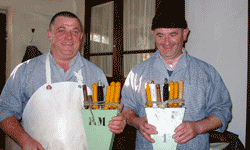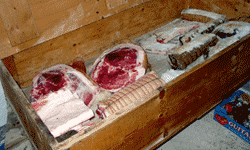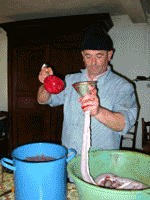Boudin Noir

- SUBSCRIBE
- ALREADY SUBSCRIBED?
BECOME A BONJOUR PARIS MEMBER
Gain full access to our collection of over 5,000 articles and bring the City of Light into your life. Just 60 USD per year.
Find out why you should become a member here.
Sign in
Fill in your credentials below.

Sunday morning, I was happily enthroned in my bed, surrounded by Emily, the six cats (Robbie Jackson, though not my cat, has moved into the house for the time being) and THE NEW YORK TIMES. Space was tight. I was looking forward to a leisurely day with the paper. I might even not get dressed. So what if the news was two months old; you’d be surprised how little difference that made. About three-quarters of the way through an article about a Manhattan family of five living the luxurious life in a 2.5 million-dollar 1880 townhouse that is twelve feet wide, the phone rang. It was my friend Laurie (also a transplanted New Yorker) calling from her truck, “We’re going up to get hay from the old guy with the goose farm above Dieulefit. I’ve organized a group–pick you up in twenty minutes!” Goose farm? Hay? An hour each way in a truck? Could I wear my pajamas? Bring the paper? And the bed? Still, the prospect of a goosey afternoon in the mountains had a certain appeal…. But what about the family in the “modular and theatrical, distinct but polyfunctional” townhouse “brightly painted up and down the color spectrum” with a basement “painted harlequin-style in curry and cinnamon” by an opera singer friend? Their “vertical life” in the 12-foot house would have to wait.
Twenty minutes later, Emily and I were climbing into the cab of Laurie’s truck, seated next to Alexandra, her holistic chiropractor/friend, who also needed hay for her horse. Mike and Zack, tree surgeons from New Hampshire who are working for Laurie pruning plane trees in the Drôme and Vaucluse, were in the back. The farther north we went, the colder it got. The mountain above Dieulefit, where Francis, the “old guy,” has his ancient, isolated farm, was covered in snow. It was a steep ascent; Laurie maneuvered the truck skillfully and we parked outside the hay barn, next to the porcherie (pig house). There were two other cars parked and no sign of Francis, something Laurie said was unusual since he almost never has visitors. We walked around the various outbuildings calling him. I was looking for geese and Emily was racing and rolling madly in the snow. Finally Francis emerged from one of the barns, an elderly but spry man with an unlined, childlike face and a small white mustache. He was sporting a navy beret, the French worker’s blue smock and carrying two enormous dead rabbits in his left hand. Laurie introduced us while Emily made a lunge for the lapins. Francis explained he’d forgotten we were coming; he’d been busy all day with a pig.
The pig’s owners had driven up from Aix-en-Provence at 5 A.M. that morning and the butcher/slaughterers, two cheerful brothers, had been working all day. We were just in time for the boudin noir (blood sausages). Oh, goody.
But first we had to load the truck with hay for Laurie’s horses. Francis put the dead rabbits inside the porcherie and opened the heavy wooden doors to the barn, which was neatly stacked to the ceiling with bales of hay. In fact, as I looked around, I saw Francis is definitely a compulsively neat sorter and stacker–piles of firewood arranged and stacked according to size, ditto for kindling, animal feed, buckets and pails. He could probably do wonders for my desk. The hay was heavy–Francis used a pitchfork–and after about twenty minutes with six of us working, the bales were tightly packed into the truck. We all had that horsy smell, minus the manure, of course.
I still had not seen any geese. I asked Francis if he could show us around; I especially wanted to see the animals. We went into the poultry barn; there were about 100 enormous chickens strutting about. Emily was enthralled but intimidated. Francis was especially proud of his stone trough, which was a few hundred years old. We made an appropriate fuss and I took a picture. He was pleased. He was born on the farm around 80 years ago and essentially has never left; his parents and grandparents were born there as well. Very little has changed. His is one of the few truly organic old-fashioned farms left; he is known throughout Provence. His chickens command a hefty price, between 20 and 30 euros apiece. The turkeys are between 80 and 100. I asked about the geese. He didn’t have any now; he doesn’t like them. They’re too bossy and don’t mind their own business, he explained. He’d gotten rid of them all at Christmas….
Next we went to see the lapins. Neat stacks in long rows of large cages, each with several exquisite rabbits. One cage was empty. I thought of the two rabbits, lying dead on the slab of wood in the porcherie and did not linger long in the bunny barn.
We went into the house, which had no heating other than an enormous walk-in fireplace. A black cauldron of blood was bubbling away, hanging from a hook over the ember-flaked logs. We all put our backs to the fire, trying to get hold of some warmth. The newly laundered pig intestines were spread out on a large wooden table ready to be stuffed with blood. The average length of a pig’s small intestine is 60 feet. I mentally noted blood-sausage making would probably not be a viable project for the family in the 12-foot-wide house. Also, the color scheme probably wasn’t quite “them.”
Today very few people buy piglets to home-raise for slaughter. Though once common, the custom pretty much died out in the late 1970s. In the old days, slaughtering the pig was a big social event with family, friends and neighbors all taking part. Francis is one of a handful of farmers left who hand-raise piglets. Generally he does three at a time. They are not his, but are bought as piglets by gourmet purveyors (the two gentlemen from Aix) who then pay Francis to hand-raise them. When the pigs are ten months old, the jolly roving brother butchers, Pierre-Michel and Alain-Pierre, are hired for the day by the purveyors. Theirs is a dying art. Not only do they humanely slaughter the pig (a small cylinder is placed on its head and a pellet goes swiftly to its brain, killing it instantly and without pain), but they also cut, salt and tie the meat for petit salé, jambon cru, roulade, chops and roasts, as well as make rillettes, saucissons, boudin noir, caillettes and pâté for the purveyors to sell. They arrive with all the necessary equipment, which they proudly showed us, including their little green-wooden knife holsters. While Alain-Pierre prepared to start work on the boudins, Pierre-Michel and Francis showed us the saloir, a long slope-sided wooden box, similar in shape to a coffin, with a hole at one end. The bottom of the saloir is spread with a thick layer of rock salt, the hams placed on top and then more salt is added. The hams have to be turned every day for 20 days; then they are rubbed with black pepper and wrapped in loose cloth and are hung in a cool and aerated cave (cellar) where it takes around nine months for them to dry and become prized jambon cru. (In France, jambon sandwiches are eaten with butter, never mustard, spread on a crusty baguette–strictly kosher!) There were also numerous roulades in Francis’s saloir. Roulade, more commonly known as pancetta, is made by laying the pork belly flat, seasoning it with a layer of salt, pepper, ground juniper, sarriette (winter savory) and thyme and then tightly rolling it, tying it at close intervals with butcher’s twine. Roulades are turned for only five or six days in the saloir before being wrapped in cloth and hung to cure for four or five months. There were also several unrolled slabs of petit salé (pork belly) taking the “cure.” Around a dozen freshly killed and plucked chickens and ducks were resting on a large wooden table, soon to be joined by the two rabbits Francis was about to skin.
It was time for the boudin noir (“boo-dahn nwahr”), blood sausages known as black pudding in the U.K., blutwurst in Germany and morcilla in Spain. Alain-Pierre had everything laid out on the long kitchen table: tall blue-enamel pot of pig blood mixed with onions, fat, nutmeg, cloves, allspice, cinnamon and brandy; a ladle, metal funnel and wide green-rubber bowl. The washed intestines were already there. We had missed the flushing out. Francis was getting his knives ready to skin the rabbits. There was no place to avert one’s eyes. Alain-Pierre took a length of intestine and slid one end over the mouth of the metal funnel. He tied a knot with his mouth and some string at the other end. Then he ladled in the blood mixture till the raw intestine swelled; every six inches or so, he did another knot with the string and his mouth. There was a lot of intestine to get through, not to mention blood. A pig of 200 to 250 pounds yields on average around 13 quarts of blood. This pig had weighed 418 pounds. Pierre-Michel returned from the porcherie, where he had been heating an enormous kettle of boiling water in which to simmer the boudins. He went off with a large bunch and dunked them in after pricking them slightly so they wouldn’t burst. We followed. The little cooking room in the porcherie was filled with steam. The remaining still-live pig munched happily on veggies in his stall. Francis said he, too, was to become so much saucisson in a few days when his owners arrived. He invited us back for the slaughter, but unfortunately we were all seriously busy in the upcoming days. As the boudins were done, Pierre-Michel lifted them out to drain and cool in a flat, round wicker panier (woven basket) covered with straw.

After we had unloaded the hay in Laurie’s barn in Vinsobres and Emily had communed with her horses, we set off to find an open café, not so easy to find in the boonies of Provence on a winter Sunday night. We ended up at the hip Bar Universal on the Place Montfort in Vaison-la-Romaine. Laurie, Alexandra and the guys ordered Margaritas and beer,  I a small Chardonnay. Emily had water. The plasma-screened TV was showing snow-boarding in the Alps, skiers, surfers, whatever. Everyone was into it, except perhaps Emily and me. Laurie ordered plates of fried onions, frites and chicken wings, fried zucchini and mozzarella sticks, another round of drinks. What the hell. I wasn’t driving. I was tired, my brain and senses overworked. It had been a great day, but my bed and kitty cats beckoned. So did the NEW YORK TIMES. (Any more cats and I will need a twelve-foot wide bed.) Later that night, as I fell onto my Scottie-patterned flannel sheets, surrounded by cute, furry LIVE animals, I was grateful again, a million times over, to be where I am, living here in Provence, to know this is my home, and that no matter what, I’ve come here to stay.
I a small Chardonnay. Emily had water. The plasma-screened TV was showing snow-boarding in the Alps, skiers, surfers, whatever. Everyone was into it, except perhaps Emily and me. Laurie ordered plates of fried onions, frites and chicken wings, fried zucchini and mozzarella sticks, another round of drinks. What the hell. I wasn’t driving. I was tired, my brain and senses overworked. It had been a great day, but my bed and kitty cats beckoned. So did the NEW YORK TIMES. (Any more cats and I will need a twelve-foot wide bed.) Later that night, as I fell onto my Scottie-patterned flannel sheets, surrounded by cute, furry LIVE animals, I was grateful again, a million times over, to be where I am, living here in Provence, to know this is my home, and that no matter what, I’ve come here to stay.


